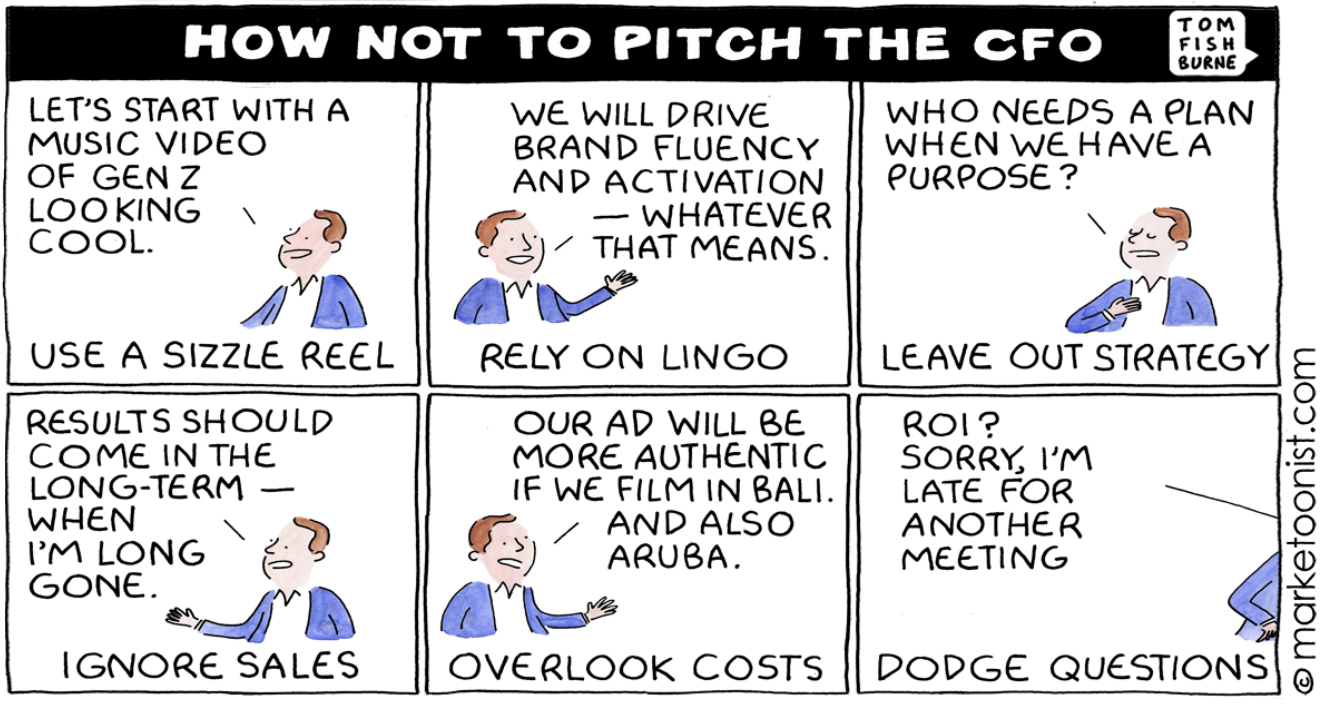Hey Marketer - does your CFO think you’re wasting money? If so, you’re not alone.
Proving value to Chief Financial Officers has been a longstanding challenge for marketers. Over 45% of marketers feel increasing pressure to prove the value of marketing initiatives to CFOs. CMOs want to demonstrate financial impact in order to secure future marketing budgets and show accountability for business results. However, marketing measurement and outcomes are often less precise than the measurement of other business activities.
Rather than relying on marketing lingo and buzzwords (see image below), we’ve broken down steps marketing experts can take to prove the value of their campaigns to their CFO.

|
Source: Marketoonist
Step 1: Prioritize Business Objectives
The first step in proving marketing value to your CFO is prioritizing your company’s business objectives. Because marketing and finance are entirely different areas, explaining the marketing budget to the CFO of your organization can be challenging. Demonstrating how marketing contributes to the bottom line helps other departments see its correlation with positive financial outcomes. Emphasizing actionable metrics, such as customer retention, and sales, will ensure that other departments see how marketing dollars are benefiting the business as a whole. Working closely with the finance team to determine what metrics to focus on is a helpful way to ensure that value is being proven on both sides.
However, focusing only on measurable results under-represents marketing’s full impact. If the marketing budget is poorly planned, the CFO may disapprove. On the other hand, too much restriction on experimentation and iterations can pose an unwanted limit to the marketing team's creativity. CMOs need to balance between prioritizing business objectives and also recognizing other long term and positive influences marketing campaigns can have on the wellbeing of the company. For example, some initial re-engagement campaigns may have low conversions but help increase overall brand recognition and awareness. Being patient with marketing campaigns can yield results that CFOs are looking for.
Step 2: Collaborate with Sales
The second step on the path to proving marketing value to your CFO is to collaborate with the sales team. Pitching ideas to sales before taking the marketing budget plan to the finance department helps marketers recognize the direct support they give to the sales team. Sales and marketing should be aligned to maximize return on investment.
An integrated work approach will also demonstrate a greater understanding of the overall business objectives and how the marketing strategy will help achieve this. When sales and marketing work together rather than focusing on separate activities, they can support each other to hit their targets. Organizations where sales and marketing work well together are reported to close 30% more deals than those who work separately. Proving there is value to sales within the marketing plan can change the CFO’s view of the marketing team from being a cost center to a profit center.
Step 3: Know the ROI on Projects
CFOs all have one thing in common – their main focus is the economic recovery of business expenses. They look to maximize all spend in order to yield results for their company. Marketers, on the other hand, usually need to spend money first in order to bring in leads or new, paying users. For instance, paid re-engagement campaigns increase the lifetime value of users in the long term. Investing in users that are already interested in your product is an easy win. Having a clear marketing plan in order to demonstrate how the budget is intended to be spent will help CFOs feel confident in that strategy.
In order to demonstrate marketing’s ROI, outlining metrics such as KPIs is pivotal. Most marketing leaders have a set of KPIs they use to demonstrate impact on financial outcomes, and it’s critical to be thoroughly knowledgeable about them. For example, being able to showcase the number of conversions for a given campaign and time frame is a surefire way for CFOs to approve of the additional expense in the future.
Step 4: Explain Marketing Uncertainty
Although the value of many marketing projects can be summarized with distinct KPIs, other projects have a level of ambiguity. Deep knowledge of metrics can build a marketer’s credibility when presenting to finance executives. Explaining marketing’s inherent uncertainties is important as well. Marketing’s environment is typically much “noisier” than that of sales or finance departments. There are many unknown, unpredictable, and uncontrollable factors that get in the way of precise measurement.
Marketing projects may also work over multiple time frames. For example, while sales and demand generation takes place in the current quarter, brand-building actions could take years to cumulate. It is also often difficult to attribute financial outcomes solely to marketing, as sales and other departments step in to drive final results. For example, marketing may drive inbound leads but sales will be the department to push them to the end of the funnel, driving profits. Marketing uncertainties like these should be explained to the top management team as being inherent to the task of marketing, not the result of a sloppy measurement system.
Takeaways of Proving Marketing Value to Your CFO
Over 70% of marketing execs reported that demonstrating the value of marketing to the CEO, CFO, and the board is critical this year. Collaboration between the marketing team and CFOs has paved the way for many high-growth companies to succeed. Here are 4 steps that marketers should take in order to show their CFO’s that they are not wasting their money.
- Prioritize Business Objectives: Because marketing and finance are entirely different areas, explaining the marketing budget to the CFO of your organization can be challenging. Emphasizing actionable metrics, such as customer retention, and sales, will ensure that other departments see how marketing dollars benefit the business as a whole.
- Collaborate with Sales: Pitching ideas to sales before taking the marketing budget plan to the finance department helps marketers recognize the direct support they give to sales. Sales and marketing should be aligned to maximize return on investment.
- Know the ROI on Projects: CFOs all have one thing in common – their main focus is the economic recovery of business expenses. Having a clear marketing plan to demonstrate how the budget is intended to be spent helps CFOs feel confident in their strategy.
- Explain Marketing Uncertainty: While deep knowledge of your department’s KPIs can build a marketer’s credibility when presented to finance executives, explaining marketing’s inherent uncertainties is important as well. Marketing’s environment is typically much “noisier” than that of sales or finance departments so results may take longer or look different than that of other business areas.




